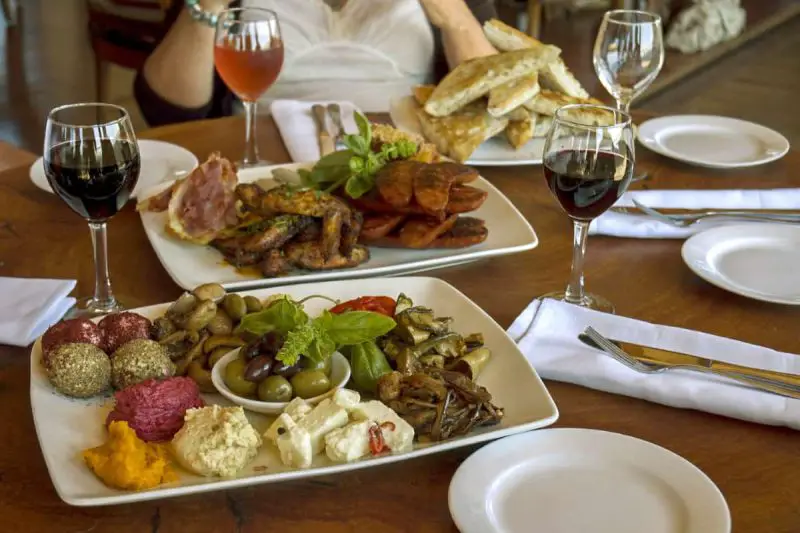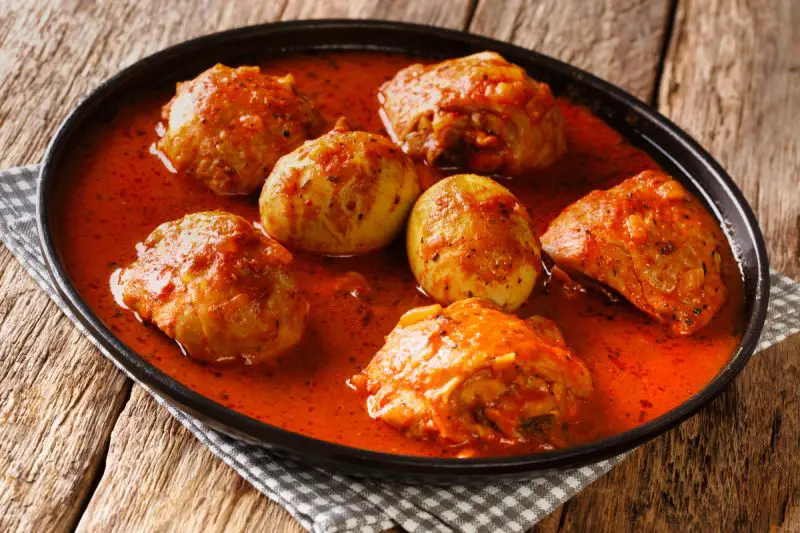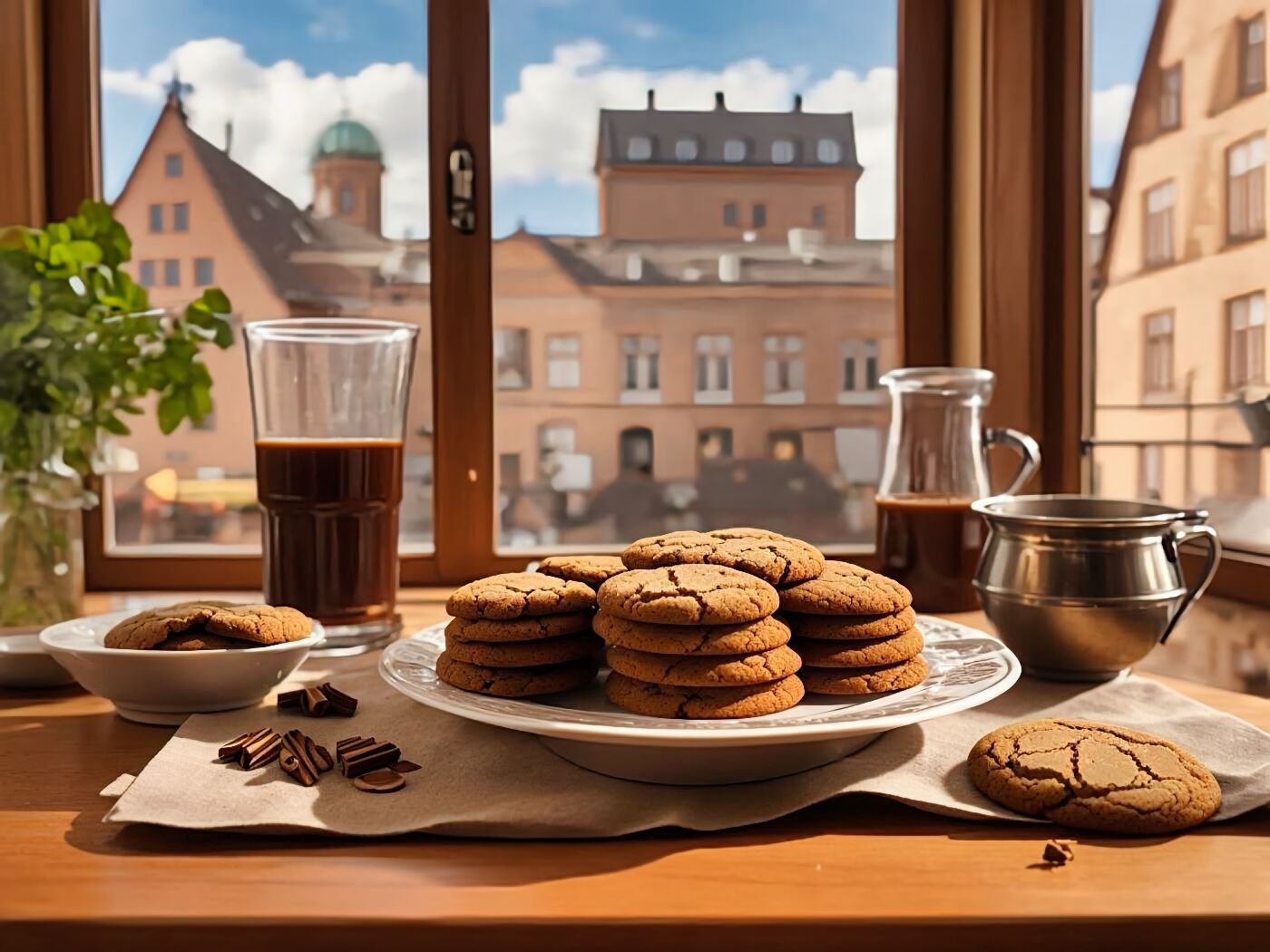
The German Pfeffernuesse Recipe is a traditional German holiday treat that is often enjoyed during the festive season. These small, round cookies are packed with rich flavors and have a delightful texture. Made with a combination of spices and a hint of sweetness, German Pfeffernuesse cookies are a delight for the taste buds.
The recipe for German Pfeffernuesse involves a few key ingredients such as flour, butter, sugar, eggs, and a blend of spices. These spices typically include ground cinnamon, cloves, nutmeg, and black pepper, which give the cookies their distinct and aromatic flavor. The dough is mixed together and rolled into small balls before being baked to perfection.
Want more ideas to round-out your Brazilian Recipes Box?
A lot of great options are in these posts!
25 Easy Authentic German Food Recipes
One of the unique aspects of German Pfeffernuesse cookies is their versatility. They can be enjoyed as a standalone treat or paired with a cup of warm tea or coffee. The cookies are often dusted with powdered sugar, which adds a touch of sweetness and a visually appealing finish.
In addition to their delicious taste, German Pfeffernuesse cookies can also offer some potential health benefits. The spices used in the recipe, such as cinnamon and cloves, have been associated with various health-promoting properties. For example, cinnamon is believed to have anti-inflammatory and antioxidant effects, while cloves are known for their antimicrobial properties. However, it’s important to note that these potential benefits come from the spices themselves and not specifically from the cookies.
You May Want to Join The World Recipes With Our Big Escape
Share your own recipes in our Facebook Group. Find recipes from all over the world. Learn more about International Cuisine and how you can surprise your family with new and exciting foods from all over the world.
For More Photos Visit Our Instagram at World Recipes Daily
German Pfeffernuesse cookies are a wonderful addition to holiday celebrations and make for a tasty homemade gift. Their flavorful combination of spices and versatile nature make them a favorite among cookie lovers. So, if you’re looking to try something new and delicious, give the German Pfeffernuesse recipe a try and enjoy these delightful treats!
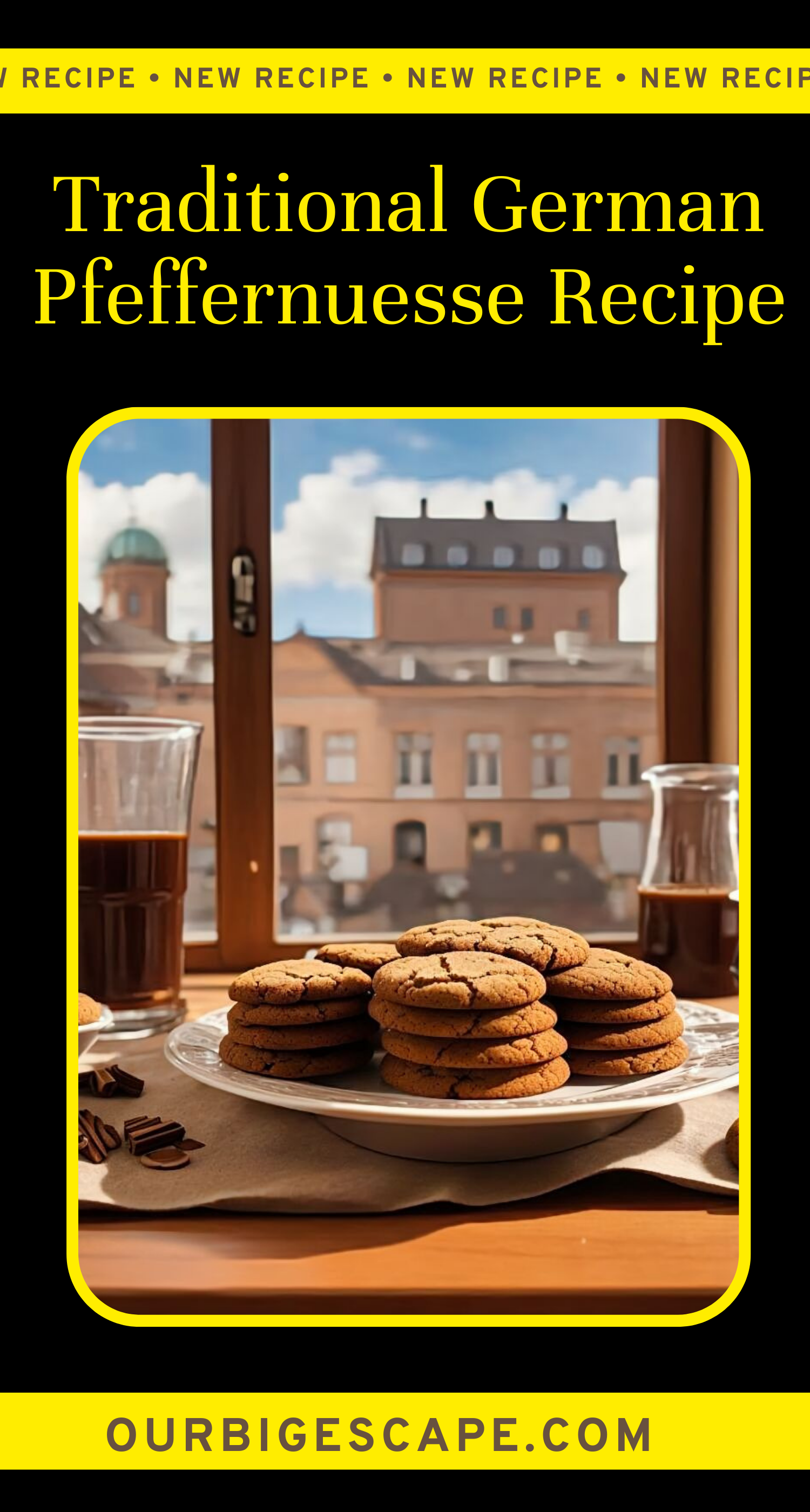
How To Make Our German Pfeffernuesse Recipe
Ingredients (8 Servings)
For the Pfeffernuesse
4 teaspoons Lebkuchengewürz
3 tablespoons heavy cream
1 cup molasses
1/2 cup purehoney
1/2 cup shortening
5 tablespoons butter, unsalted
2 eggs, large
4 cups all-purpose flour
1/4 cup almond meal
1/2 cup white sugar
1/2 cup brown sugar, packed
1/4 teaspoon white pepper, finely ground
2 teaspoons anise extract
2 teaspoons cinnamon, ground
1 ½ teaspoons cardamom, ground
1 ½ teaspoons baking soda
1 teaspoon cloves, ground
1 teaspoon nutmeg, ground
1 teaspoon ginger, ground
1 teaspoon black pepper, ground
½ teaspoon salt
For the Glaze
3-4 tablespoons hot water (less water will result in a thicker & whiter glaze)
2 1/2 cups powdered sugar
Instructions
1. Preparing the Dough:
a. In a large mixing bowl, combine Lebkuchengewürz, heavy cream, molasses, honey, shortening, unsalted butter, and eggs.
b. Mix the ingredients together until well combined.
c. In a separate bowl, whisk together all-purpose flour, almond meal, white sugar, brown sugar, finely ground white pepper, anise extract, ground cinnamon, ground cardamom, baking soda, ground cloves, ground nutmeg, ground ginger, ground black pepper, and salt.
d. Gradually add the dry ingredient mixture to the wet ingredients, stirring until a dough forms.
e. Once the dough is mixed, cover it with plastic wrap and refrigerate for at least 2 hours or overnight to allow the flavors to meld.
2. Shaping the Cookies:
a. Preheat the oven to 350°F (175°C) and line baking sheets with parchment paper.
b. Take out the chilled dough from the refrigerator.
c. Pinch off small portions of the dough and roll them into 1-inch balls.
d. Place the dough balls on the prepared baking sheets, spacing them about 2 inches apart.
e. Flatten the dough balls slightly with the bottom of a glass or your fingers.
3. Baking the Pfeffernuesse:
a. Put the baking sheets in the preheated oven and bake for 10-12 minutes, or until the cookies are firm to the touch.
b. Remove the cookies from the oven and let them cool on the baking sheets for a few minutes.
c. Transfer the cookies to a wire rack to cool completely.
4. Preparing the Glaze:
a. In a small mixing bowl, combine powdered sugar and hot water.
b. Stir the mixture vigorously until a smooth glaze forms. Adjust the consistency by adding more powdered sugar or water as needed.
5. Glazing the Cookies:
a. Dip each cooled Pfeffernuesse cookie into the glaze, allowing any excess to drip off.
b. Place the glazed cookies back on the wire rack to allow the glaze to set.
6. Serving and Storing:
a. Once the glaze has hardened, transfer the German Pfeffernuesse cookies to a serving platter.
b. Serve them as a delightful holiday treat or package them as gifts.
c. Store any leftovers in an airtight container at room temperature for up to 1 week.
Estimated Prep Time: 20 minutes
Estimated Cooking Time: 10-12 minutes per batch of cookies
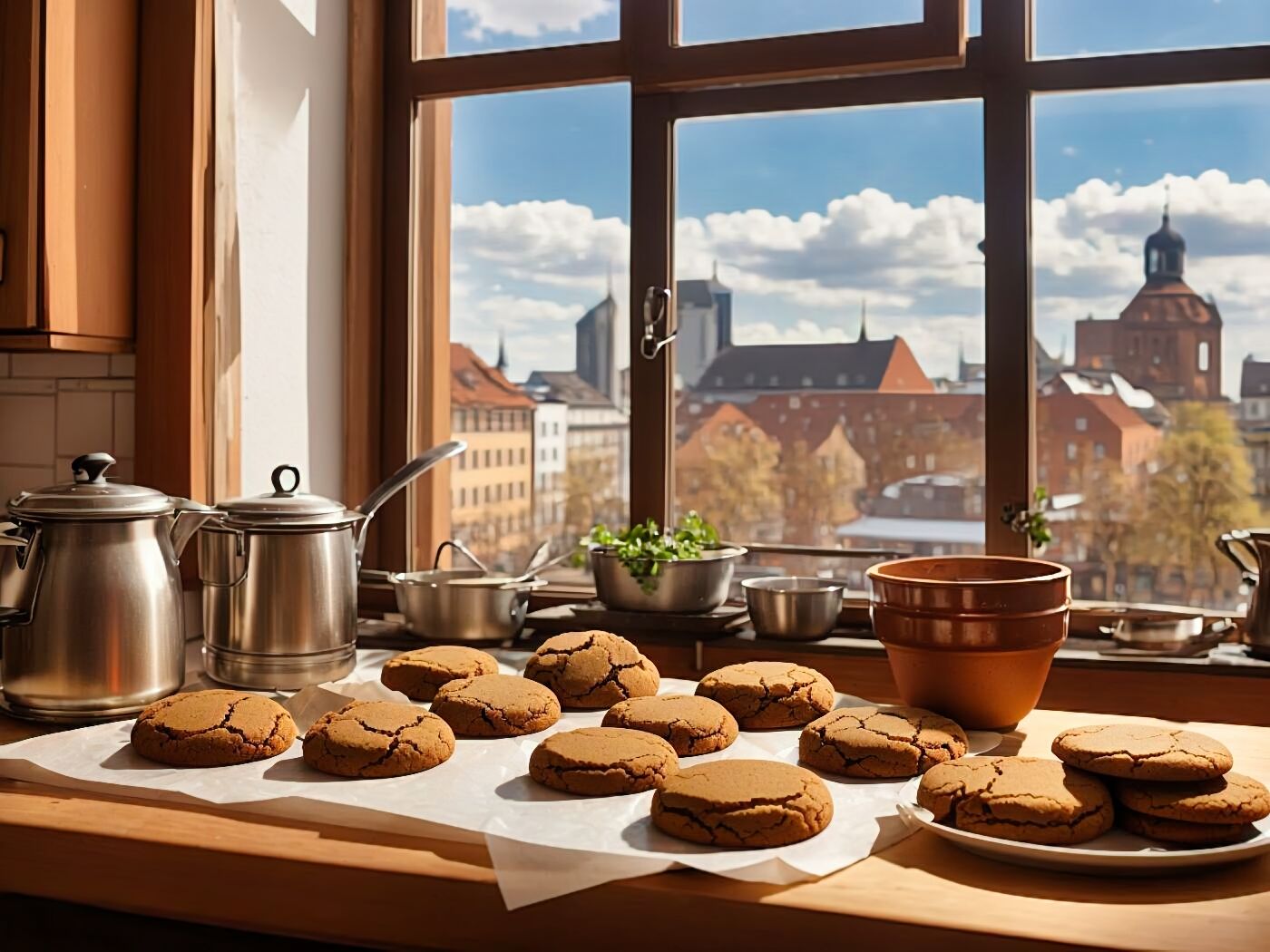
Pots, Pan and Cooking Equipment Needed for the German Pfeffernuesse Recipe
Mixing bowls
Whisk
Measuring cups and spoons
Large baking sheets
Parchment paper
Wire rack
Small mixing bowl
Best Way to Store Leftovers From the the German Pfeffernuesse Recipe
a. Place the leftover German Pfeffernuesse cookies in an airtight container.
b. Make sure the container is clean and dry before storing the cookies.
c. Store the container in a cool, dry place away from direct sunlight.
d. Alternatively, you can use a resealable plastic bag for storing the cookies.
e. Label the container or bag with the date to keep track of freshness.
Tips and Tricks For Easier Creation
Allow the dough to chill for at least 2 hours or overnight for better flavor development.
Use a cookie scoop or melon baller to portion out the dough for consistent cookie sizes.
Flatten the dough balls slightly before baking to ensure even baking.
If the dough is sticky, lightly dust your hands with flour when rolling the balls.
Dust the bottom of the glass or your fingers with flour to prevent sticking when flattening the dough.
If you prefer a spicier flavor, you can increase the amount of ground black pepper in the recipe.
Sift the powdered sugar for the glaze to ensure a smooth and lump-free consistency.
Side Dishes and Desserts For the the German Pfeffernuesse Recipe
a. Hot cocoa or spiced cider
b. Assorted holiday cookies
c. Vanilla ice cream or whipped cream
d. Sliced fresh fruits like oranges or pears
How To Serve the German Pfeffernuesse Recipe
a. Arrange the German Pfeffernuesse cookies on a festive platter.
b. Dust the cookies with additional powdered sugar for an extra touch of sweetness.
c. Serve the cookies alongside a warm cup of tea or coffee.
d. Encourage guests to dip the cookies in hot cocoa or cider for a delicious treat.
e. If gifting, place the cookies in decorative boxes or cookie tins.
f. Include a note with the cookies’ name and ingredients for those with dietary restrictions.
Dietary Substitution For the German Pfeffernuesse Recipe
1. Vegan Options for the German Pfeffernuesse Recipe:
a. Substitute the heavy cream with coconut cream or almond milk.
b. Use maple syrup instead of honey.
c. Replace the butter with vegan margarine or coconut oil.
d. Use flax eggs or applesauce as a substitute for eggs.
e. Ensure the molasses is vegan-friendly by checking for any animal-derived ingredients.
f. Use plant-based shortening instead of regular shortening.
g. Check the Lebkuchengewürz blend for any non-vegan ingredients and opt for a vegan-friendly version if needed.
2. Gluten-Free Options for the German Pfeffernuesse Recipe:
a. Use a gluten-free Lebkuchengewürz blend or create your own gluten-free spice mix.
b. Replace all-purpose flour with a gluten-free flour blend suitable for baking.
c. Substitute almond meal with a gluten-free alternative, such as finely ground gluten-free oats or additional gluten-free flour.
d. Use gluten-free certified molasses and pure honey.
e. Check the labels of your ground spices for any potential gluten contamination.
f. Ensure the baking soda and baking powder used are gluten-free.
g. Verify that the powdered sugar used in the glaze is gluten-free.
3. Vegetarian Options for the German Pfeffernuesse Recipe:
a. No specific substitutions are required as the original recipe is vegetarian-friendly.
4. Mediterranean Diet Options for the German Pfeffernuesse Recipe:
a. No specific substitutions are required as the original recipe aligns with the Mediterranean diet.
5. Keto Diet Options for the German Pfeffernuesse Recipe:
a. Replace the molasses and honey with a low-carb sweetener, such as stevia or erythritol.
b. Substitute all-purpose flour with almond flour or a combination of almond flour and coconut flour.
c. Use a keto-friendly shortening or coconut oil instead of regular shortening.
d. Check the Lebkuchengewürz blend for any added sugars or high-carb ingredients.
e. Adjust the amount of sweetener used in the glaze to fit your keto requirements.
f. Ensure the spices used in the recipe are carb-friendly and do not contain fillers.
g. Use a low-carb powdered sugar substitute for the glaze or omit it altogether.
6. Heart Healthy Diet Options for the German Pfeffernuesse Recipe:
a. Replace the shortening with a heart-healthy oil, such as olive oil or avocado oil.
b. Use a whole wheat flour or whole grain flour instead of all-purpose flour.
c. Choose low-sodium molasses and honey options.
d. Opt for unsalted butter or reduce the amount of salt used in the recipe.
e. Ensure the Lebkuchengewürz blend does not contain any added sodium.
f. Consider reducing the amount of sugar used or use a natural sugar substitute.
g. Serve the cookies in moderation as part of a balanced heart-healthy diet.
7. Paleo Options for the German Pfeffernuesse Recipe:
a. Substitute the Lebkuchengewürz blend with a paleo-friendly spice mix, avoiding any non-compliant ingredients.
b. Replace all-purpose flour with almond flour or a combination of almond flour and coconut flour.
c. Use coconut cream instead of heavy cream.
d. Choose paleo-approved sweeteners, such as maple syrup or coconut sugar, instead of molasses and honey.
e. Opt for grass-fed butter or ghee as a substitute for unsalted butter.
f. Ensure the almond meal used is blanched almond flour to maintain paleo compliance.
g. Use a paleo-friendly powdered sugar substitute for the glaze or omit it if desired.
8. Low Carb Options for the German Pfeffernuesse Recipe:
a. Replace the Lebkuchengewürz blend with a low-carb spice mix, avoiding any high-carb ingredients.
b. Use almond flour or a combination of almond flour and coconut flour instead of all-purpose flour.
c. Substitute heavy cream with unsweetened almond milk or coconut cream.
d. Use low-carb sweeteners, such as stevia or erythritol, instead of molasses and honey.
e. Opt for unsalted butter or reduce the amount of salt used in the recipe.
f. Ensure the almond meal used is finely ground and low in carbs.
g. Use a low-carb powdered sugar substitute for the glaze or omit it altogether.
9. Whole30 Options for the German Pfeffernuesse Recipe:
a. Create a Whole30-compliant Lebkuchengewürz spice mix without any non-compliant ingredients.
b. Use almond flour or a combination of almond flour and coconut flour instead of all-purpose flour.
c. Substitute heavy cream with compliant almond milk or coconut cream.
d. Choose Whole30-approved sweeteners, such as date paste or applesauce, instead of molasses and honey.
e. Opt for clarified butter or ghee as a substitute for unsalted butter.
f. Ensure the almond meal used is compliant with Whole30 guidelines.
g. Omit the glaze or use a Whole30-approved alternative, such as a drizzle of almond butter.
10. Weight Watchers Options for the German Pfeffernuesse Recipe:
a. Adjust the quantities of sugar used in the recipe to reduce the overall points value.
b. Use a sugar substitute with zero or low points value instead of honey and molasses.
c. Substitute all-purpose flour with a lighter alternative, such as a whole wheat pastry flour or a mix of almond flour and oat flour.
d. Opt for unsalted butter or reduce the amount of salt used.
e. Use fat-free Greek yogurt or unsweetened applesauce as a substitute for heavy cream.
f. Adjust the glaze recipe to reduce the amount of powdered sugar or use a sugar-free powdered sugar substitute.
g. Serve the cookies in controlled portions to fit within your daily points allowance.
11. Low Fat Options for the German Pfeffernuesse Recipe:
a. Use fat-free Greek yogurt or unsweetened applesauce instead of heavy cream.
b. Substitute unsweetened applesauce for part or all of the butter or shortening.
c. Reduce the amount of sugar used in the recipe.
d. Opt for a low-fat powdered sugar substitute or omit the glaze entirely.
e. Choose low-fat or fat-free milk alternatives, such as almond milk or skim milk, if needed.
f. Use low-fat almond meal or reduce the amount used in the recipe.
g. Serve the cookies in moderation as part of a balanced low-fat diet.
12. Vegetable Variations for the German Pfeffernuesse Recipe:
a. Add finely grated carrots or zucchini to the dough for extra moisture and nutrients.
b. Mix in chopped dried fruits, such as raisins or cranberries, to add a burst of flavor.
c. Incorporate finely chopped nuts, such as walnuts or pecans, for added crunch.
d. Include grated orange zest to bring a citrusy twist to the cookies.
e. Sprinkle unsweetened shredded coconut on top of the glaze for a tropical touch.
f. Dust the cookies with ground matcha powder for a vibrant green color and a hint of earthy flavor.
g. Add a tablespoon of cocoa powder to the dough for a chocolatey variation.
Please note that the given substitutions are general suggestions, and individual dietary needs and preferences may vary. It’s always recommended to check labels, choose quality ingredients, and consult with a healthcare professional or registered dietitian for personalized advice.
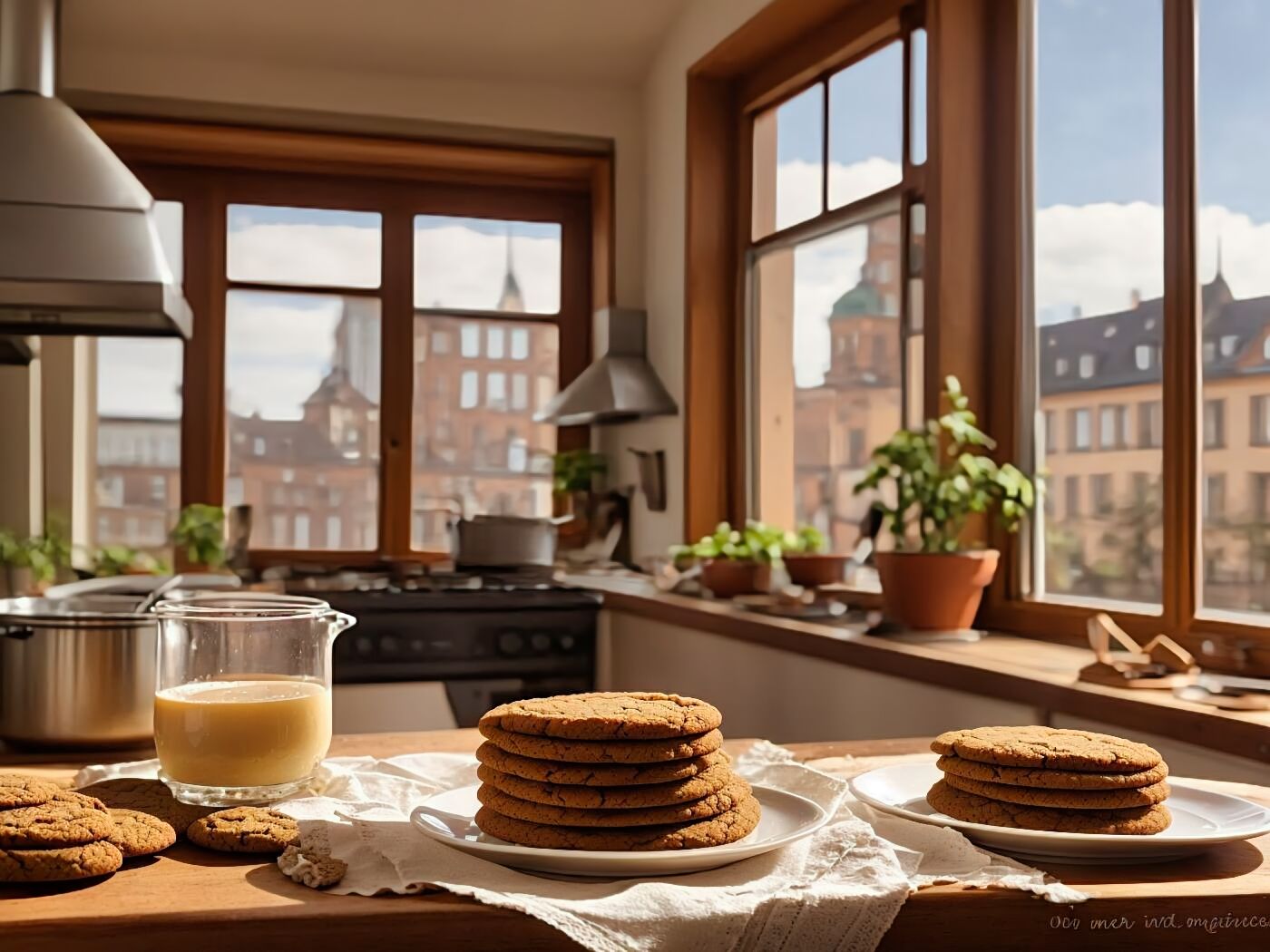
FAQ About the German Pfeffernuesse Recipe
What is the German Pfeffernuesse Recipe?
The German Pfeffernuesse Recipe is a traditional German holiday treat. These small, round cookies are made with a flavorful blend of spices, including Lebkuchengewürz, and ingredients like molasses, honey, and butter. They are then baked to perfection and often dusted with powdered sugar.
How long does it take to make the German Pfeffernuesse Recipe?
The preparation time for the German Pfeffernuesse Recipe is approximately 20 minutes, while the cookies require a baking time of 10-12 minutes per batch. Keep in mind that the dough needs to chill for at least 2 hours or overnight before shaping and baking.
Can I make substitutions in the German Pfeffernuesse Recipe?
Yes, you can make substitutions based on your dietary preferences or restrictions. For example, in the vegan version, you can replace eggs with flax eggs or applesauce, and use plant-based alternatives for dairy products. In gluten-free options, you can use gluten-free flour blends instead of all-purpose flour. It’s important to ensure the substitutes align with the desired diet or preference.
How should I store the German Pfeffernuesse cookies?
To store the German Pfeffernuesse cookies, place them in an airtight container or a resealable plastic bag. Keep them in a cool, dry place away from direct sunlight. They can be stored at room temperature for up to 1 week. Remember to label the container or bag with the date for freshness tracking.
Can I make the German Pfeffernuesse Recipe ahead of time?
Yes, you can make the German Pfeffernuesse cookies ahead of time. The dough can be prepared and chilled in advance. Once baked and cooled, the cookies can also be stored in an airtight container for a few days before serving or gifting. This makes them a convenient option for holiday preparations or homemade gifts.
Final Thoughts
German Pfeffernuesse Recipe is a delightful holiday treat that brings a burst of flavors to the palate. These small, round cookies are crafted with a blend of spices, including Lebkuchengewürz, and ingredients such as molasses, honey, and butter. They are baked to perfection, resulting in a delightful texture and a hint of sweetness. The spices used in the recipe, such as cinnamon, cloves, and ginger, create a warm and aromatic taste experience.
The versatility of German Pfeffernuesse cookies is remarkable. They can be enjoyed on their own as a delicious snack or paired with a cup of hot tea or coffee. The cookies can also be dusted with powdered sugar, adding an elegant touch and enhancing their visual appeal.
Apart from their enticing flavors, German Pfeffernuesse cookies offer potential health benefits. The spices used in the recipe, like cinnamon and cloves, have been associated with anti-inflammatory and antioxidant properties. However, it’s important to note that these benefits come from the spices themselves, rather than the cookies.
With their flavorsome taste, adaptability, and potential health advantages, German Pfeffernuesse cookies make for a delightful addition to holiday gatherings or a thoughtful homemade gift. So, go ahead and savor the rich flavors of this traditional German recipe and share the joy with your loved ones.
German Pfeffernuesse Recipe
Equipment
- Mixing bowls
- whisk
- Measuring cups and spoons
- Large baking sheets
- Parchment paper
- Wire rack
- small mixing bowl
Ingredients
- 4 teaspoons Lebkuchengewürz
- 3 tablespoons heavy cream
- 1 cup molasses
- 1/2 cup honey pure
- 1/2 cup shortening
- 5 tablespoons butter unsalted
- 2 eggs large
- 4 cups all-purpose flour
- 1/4 cup almond meal
- 1/2 cup white sugar
- 1/2 cup brown sugar packed
- 1/4 teaspoon white pepper finely ground
- 2 teaspoons anise extract
- 2 teaspoons cinnamon ground
- 1 ½ teaspoons cardamom ground
- 1 ½ teaspoons baking soda
- 1 teaspoon cloves ground
- 1 teaspoon nutmeg ground
- 1 teaspoon ginger ground
- 1 teaspoon black pepper ground
- ½ teaspoon salt
- 3-4 tablespoons hot water less water will result in a thicker & whiter glaze
- 2 1/2 cups powdered sugar
Instructions
Preparing the Dough:
- a. In a large mixing bowl, combine Lebkuchengewürz, heavy cream, molasses, honey, shortening, unsalted butter, and eggs.
- b. Mix the ingredients together until well combined.
- c. In a separate bowl, whisk together all-purpose flour, almond meal, white sugar, brown sugar, finely ground white pepper, anise extract, ground cinnamon, ground cardamom, baking soda, ground cloves, ground nutmeg, ground ginger, ground black pepper, and salt.
- d. Gradually add the dry ingredient mixture to the wet ingredients, stirring until a dough forms.
- e. Once the dough is mixed, cover it with plastic wrap and refrigerate for at least 2 hours or overnight to allow the flavors to meld.
Shaping the Cookies:
- a. Preheat the oven to 350°F (175°C) and line baking sheets with parchment paper.
- b. Take out the chilled dough from the refrigerator.
- c. Pinch off small portions of the dough and roll them into 1-inch balls.
- d. Place the dough balls on the prepared baking sheets, spacing them about 2 inches apart.
- e. Flatten the dough balls slightly with the bottom of a glass or your fingers.
Baking the Pfeffernuesse:
- a. Put the baking sheets in the preheated oven and bake for 10-12 minutes, or until the cookies are firm to the touch.
- b. Remove the cookies from the oven and let them cool on the baking sheets for a few minutes.
- c. Transfer the cookies to a wire rack to cool completely.
Preparing the Glaze:
- a. In a small mixing bowl, combine powdered sugar and hot water.
- b. Stir the mixture vigorously until a smooth glaze forms. Adjust the consistency by adding more powdered sugar or water as needed.
Glazing the Cookies:
- a. Dip each cooled Pfeffernuesse cookie into the glaze, allowing any excess to drip off.
- b. Place the glazed cookies back on the wire rack to allow the glaze to set.
Serving and Storing:
- a. Once the glaze has hardened, transfer the German Pfeffernuesse cookies to a serving platter.
- b. Serve them as a delightful holiday treat or package them as gifts.
- c. Store any leftovers in an airtight container at room temperature for up to 1 week.
